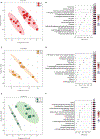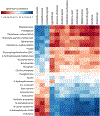The vaginal metabolome and microbiota of cervical HPV-positive and HPV-negative women: a cross-sectional analysis
- PMID: 31749298
- PMCID: PMC6982399
- DOI: 10.1111/1471-0528.15981
The vaginal metabolome and microbiota of cervical HPV-positive and HPV-negative women: a cross-sectional analysis
Abstract
Objective: Characterise the vaginal metabolome of cervical HPV-infected and uninfected women.
Design: Cross-sectional.
Setting: The Center for Health Behavior Research at the University of Maryland School of Public Health.
Sample: Thirty-nine participants, 13 categorised as HPV-negative and 26 as HPV-positive (any genotype; HPV+ ), 14 of whom were positive with at least one high-risk HPV strain (hrHPV).
Method: Self-collected mid-vaginal swabs were profiled for bacterial composition by 16S rRNA gene amplicon sequencing, metabolites by both gas and liquid chromatography mass spectrometry, and 37 types of HPV DNA.
Main outcome measures: Metabolite abundances.
Results: Vaginal microbiota clustered into Community State Type (CST) I (Lactobacillus crispatus-dominated), CST III (Lactobacillus iners-dominated), and CST IV (low-Lactobacillus, 'molecular-BV'). HPV+ women had higher biogenic amine and phospholipid concentrations compared with HPV- women after adjustment for CST and cigarette smoking. Metabolomic profiles of HPV+ and HPV- women differed in strata of CST. In CST III, there were higher concentrations of biogenic amines and glycogen-related metabolites in HPV+ women than in HPV- women. In CST IV, there were lower concentrations of glutathione, glycogen, and phospholipid-related metabolites in HPV+ participants than in HPV- participants. Across all CSTs, women with hrHPV strains had lower concentrations of amino acids, lipids, and peptides compared with women who had only low-risk HPV (lrHPV).
Conclusions: The vaginal metabolome of HPV+ women differed from HPV- women in terms of several metabolites, including biogenic amines, glutathione, and lipid-related metabolites. If the temporal relation between increased levels of reduced glutathione and oxidised glutathione and HPV incidence/persistence is confirmed in future studies, anti-oxidant therapies may be considered as a non-surgical HPV control intervention.
Tweetable abstract: Metabolomics study: Vaginal microenvironment of HPV+ women may be informative for non-surgical interventions.
Keywords: 16S rRNA gene amplicon sequencing; human papillomavirus; vaginal metabolome; vaginal microbiota.
© 2019 Royal College of Obstetricians and Gynaecologists.
Conflict of interest statement
Disclosures of interest:
JR is the co-founder of LUCA Biologics, a biotechnology company focusing on translating microbiome research into live biotherapeutics drugs for women health. All remaining authors have no disclosures to declare. Completed disclosure of interest forms are available to view online as supporting information.
Figures



Comment in
-
Re: The vaginal metabolome and microbiota of cervical HPV-positive and HPV-negative women: a cross-sectional analysis.BJOG. 2020 May;127(6):773. doi: 10.1111/1471-0528.16146. Epub 2020 Feb 24. BJOG. 2020. PMID: 32096315 No abstract available.
References
-
- Schoell WM, Janicek MF, Mirhashemi R. Epidemiology and biology of cervical cancer. SeminSurgOncol. 1999;16(3):203–11. - PubMed
-
- Pfister H. Human papillomaviruses and genital cancer. AdvCancer Res. 1987;48:113–47. - PubMed
-
- Salzman NP, Howley PM. The Papovaviridae. New York: Plenum Press; 1986.
-
- Plummer M, Herrero R, Franceschi S, Meijer CJ, Snijders P, Bosch FX, et al. Smoking and cervical cancer: pooled analysis of the IARC multi-centric case--control study. Cancer Causes Control. 2003;14(9):805–14. - PubMed
-
- International Collaboration of Epidemiological Studies of Cervical C, Appleby P, Beral V, Berrington de Gonzalez A, Colin D, Franceschi S, et al. Carcinoma of the cervix and tobacco smoking: collaborative reanalysis of individual data on 13,541 women with carcinoma of the cervix and 23,017 women without carcinoma of the cervix from 23 epidemiological studies. Int J Cancer. 2006;118(6):1481–95. - PubMed
Publication types
MeSH terms
Substances
Grants and funding
LinkOut - more resources
Full Text Sources

